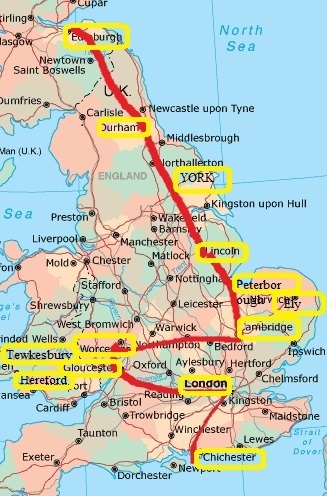U.K. 2013 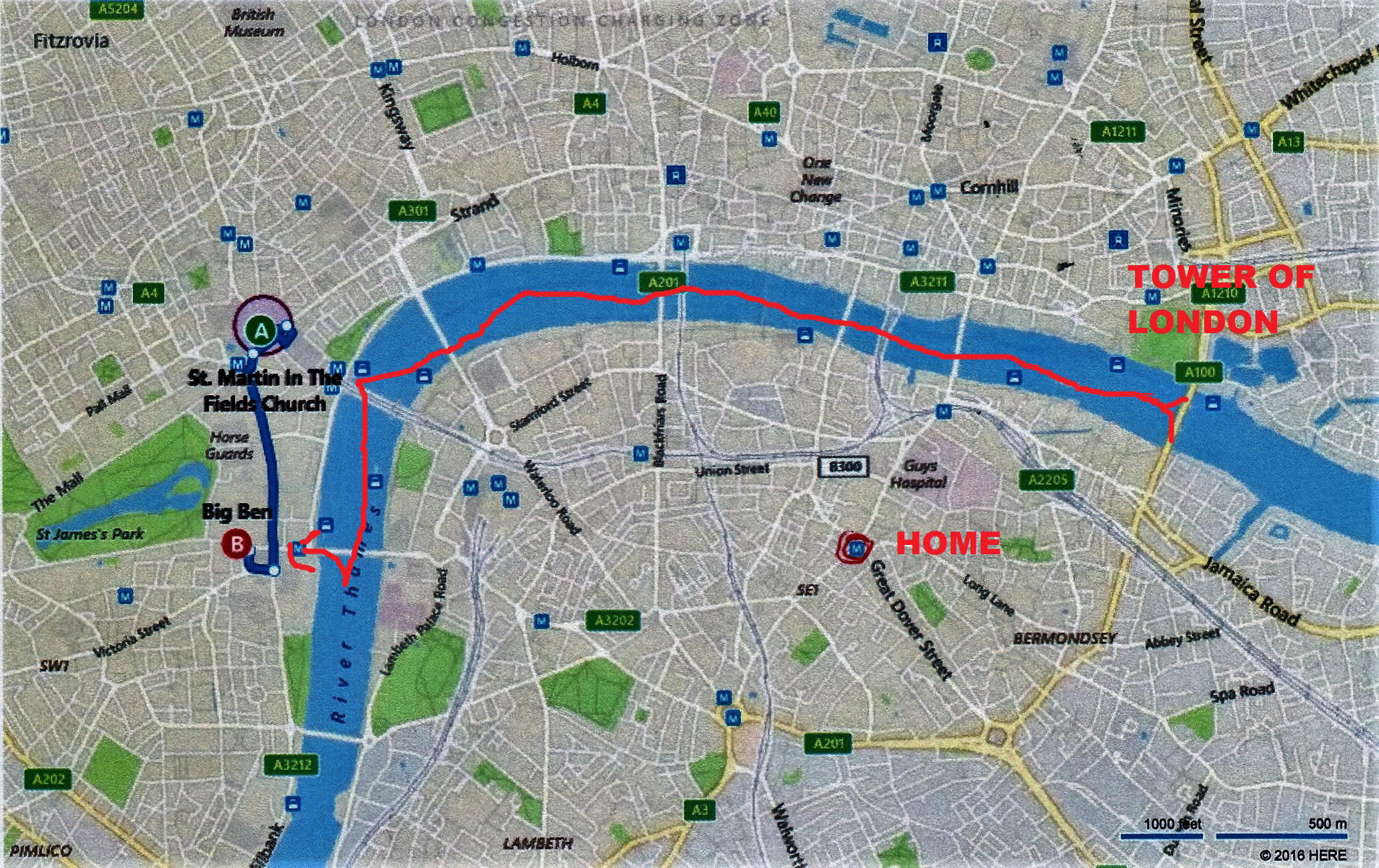
Day 19, Saturday
September 21, 2013
London
We had breakfast in our apartment…nothing gourmet! We are getting
good with the Tube (Metro or underground).
We retrac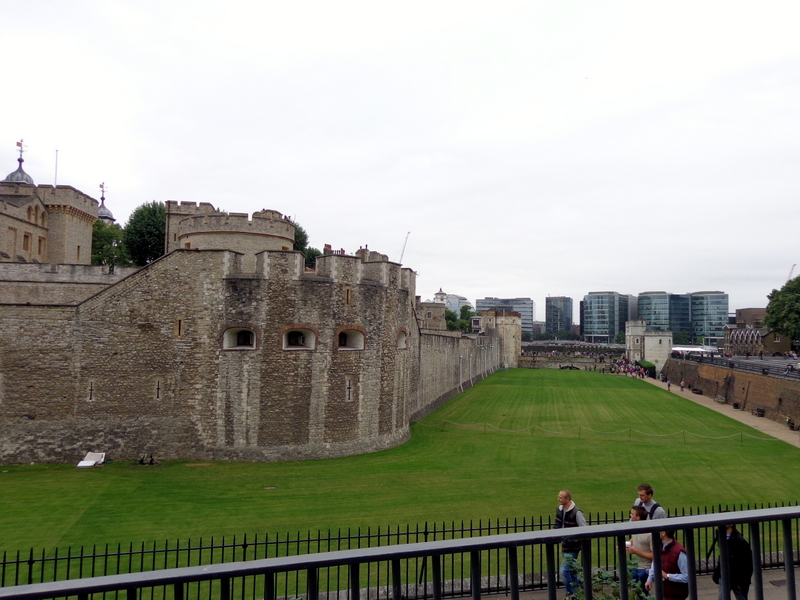 ed our steps from last night back to the Tower of London.
We bought our tickets and joined a tour.
ed our steps from last night back to the Tower of London.
We bought our tickets and joined a tour.
The guides are called Yeoman Warder. The Yeoman Warder is part of a
team of 34 men and one woman. To be a Yeoman Warder a person ne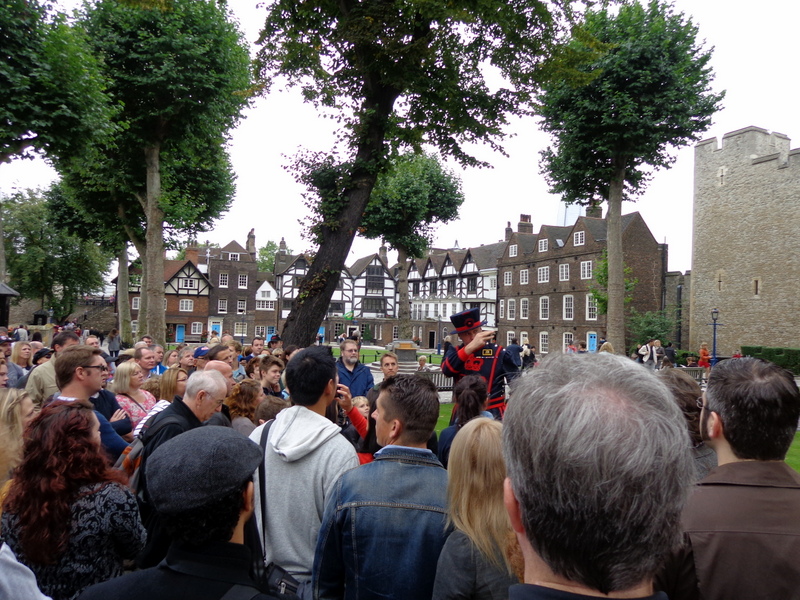 eds to
have at least 22 years of military service; to have reached the rank of
warrant officer; to have been awarded the long service and good conduct
medal and to be between 40 and 55 years old on appointment. They have
wonderful red uniforms and black hats. They get a lot of audience
participation and tell very funny stories.
eds to
have at least 22 years of military service; to have reached the rank of
warrant officer; to have been awarded the long service and good conduct
medal and to be between 40 and 55 years old on appointment. They have
wonderful red uniforms and black hats. They get a lot of audience
participation and tell very funny stories.
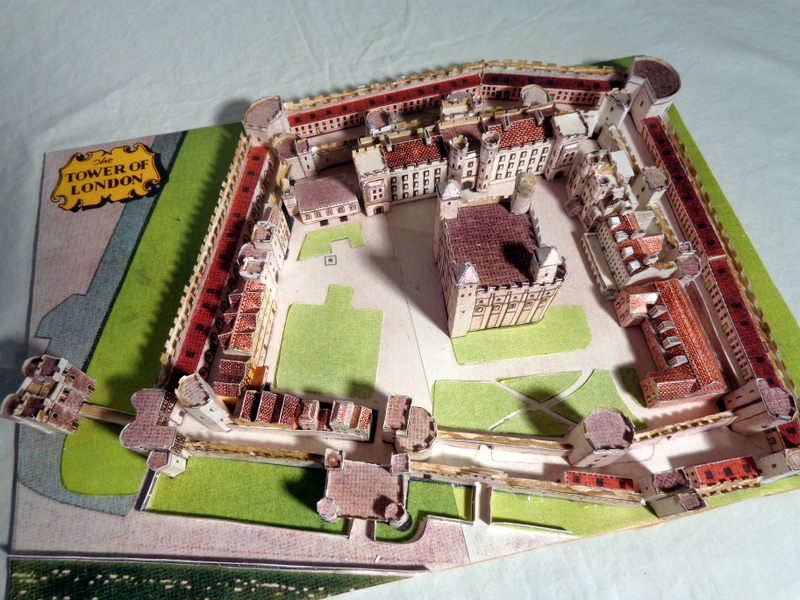 I was looking forward to seeing the Tower as I had made the model.
Everything looked just like the model or maybe it is the other way
around. The model on the left is an “aerial view” . This model is known as a
micro model and is the smallest model that I have made. The entire model
is only 14” x 10”. The White Tower in the middle is only 2” x 2”.
Click
here to see another view of the model.
I was looking forward to seeing the Tower as I had made the model.
Everything looked just like the model or maybe it is the other way
around. The model on the left is an “aerial view” . This model is known as a
micro model and is the smallest model that I have made. The entire model
is only 14” x 10”. The White Tower in the middle is only 2” x 2”.
Click
here to see another view of the model.
In the 1070s, William the Conqueror began to build a massive stone
tower at the center of his London fortress. Over 1000 years later, the
Tower of London still holds people from all
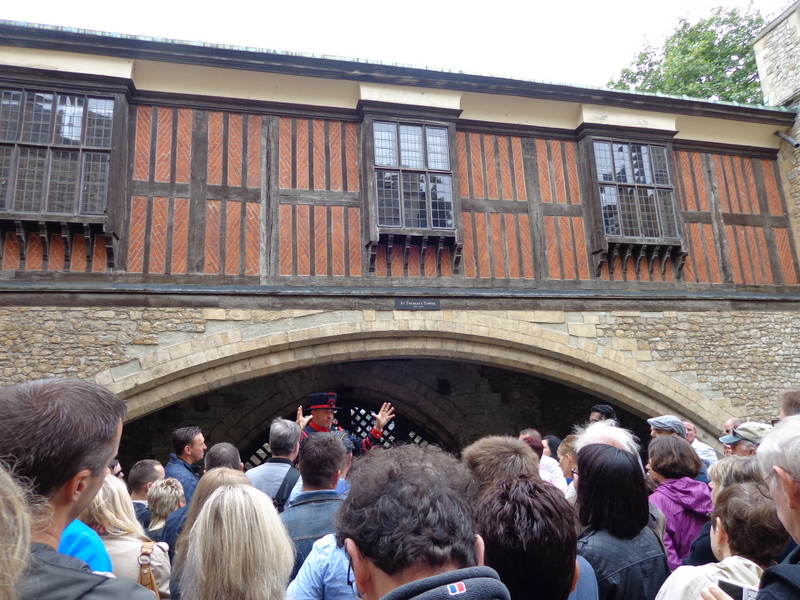 over the world in its power
and fascination. It is a World Heritage Site that welcomes over 2
million visitors a year. Countless books have been written about this
magnificent structure. Historic events of London, and indeed England,
occurred within its walls. In this brief account, I couldn’t possibly do
the history justice.
over the world in its power
and fascination. It is a World Heritage Site that welcomes over 2
million visitors a year. Countless books have been written about this
magnificent structure. Historic events of London, and indeed England,
occurred within its walls. In this brief account, I couldn’t possibly do
the history justice.
On the back of the guidebook that I purchased is a wonderful quote
by John Stow in Survey of London 1598: “This tower is
a , citadel to defend or command the city; a royal palace for assemblies
or treaties; a prison of state for the most dangerous offenders; the
only place of coinage for all England at this time; the armoury for
warlike provisions, the treasury of the ornaments and jewels of the
crown; and general conserver of the most records of the king’s courts of
justice at Westminster.”
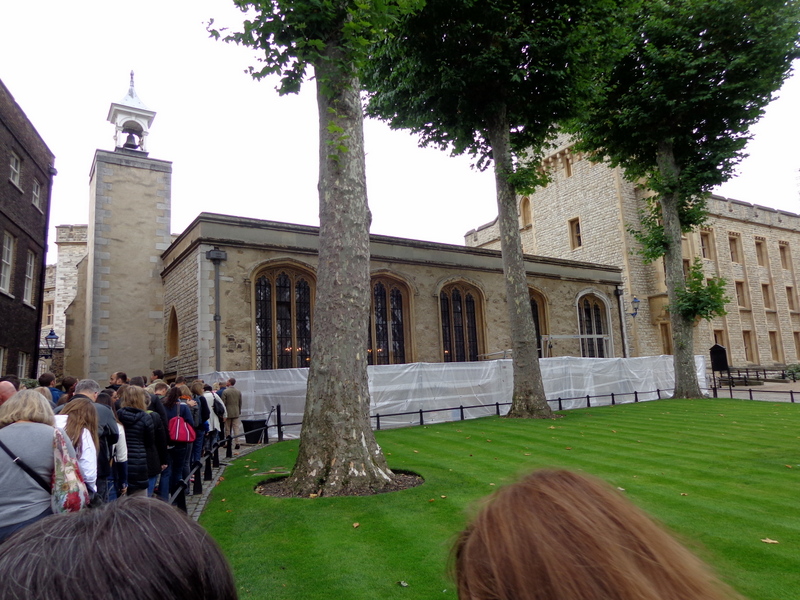 The guide took us in the Chapel Royal of St. Peter ad Vincula where
Ann Boleyn and Lady Jane Gray are buried as are many other famous
people, some of them were executed in the Tower. There are places in the
Tower where photos are not allowed, the chapel being one. The guide had
announced “no photos”. One young lady took a picture, the guide saw that
she was escorted out of the chapel.
The guide took us in the Chapel Royal of St. Peter ad Vincula where
Ann Boleyn and Lady Jane Gray are buried as are many other famous
people, some of them were executed in the Tower. There are places in the
Tower where photos are not allowed, the chapel being one. The guide had
announced “no photos”. One young lady took a picture, the guide saw that
she was escorted out of the chapel.
Near the chapel is a memorial to where10 executions took place. The
actual site of these executions was diffe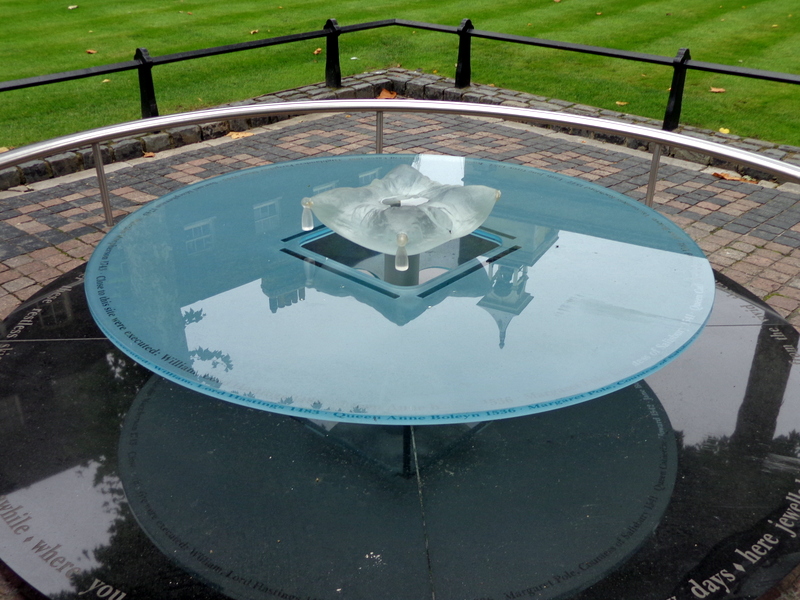 rent with a special scaffold
and block prepared each time, but all took place within a few yards
of each other. The memorial consists of a large glass circle with a
smaller raised circle above. The names of those executed are around the
edge of the circles. They include: Ann Boleyn, and the second wife of
Henry VIII; Catherine Howard, Henry’s fifth wife; Lady Jane Grey, Queen
for only nine days.
rent with a special scaffold
and block prepared each time, but all took place within a few yards
of each other. The memorial consists of a large glass circle with a
smaller raised circle above. The names of those executed are around the
edge of the circles. They include: Ann Boleyn, and the second wife of
Henry VIII; Catherine Howard, Henry’s fifth wife; Lady Jane Grey, Queen
for only nine days.
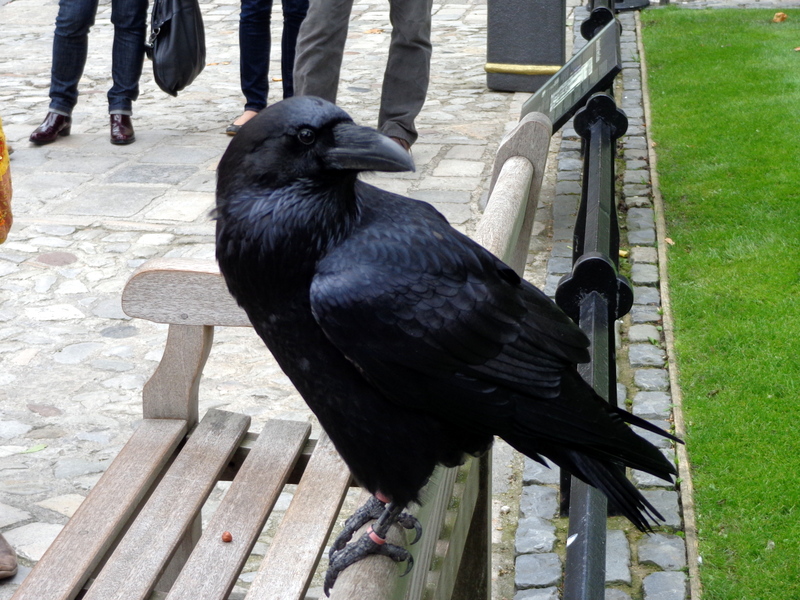 Near this memorial was a raven who seemed to pose for several
photos. Legend says that the kingdom and the Tower will fall if the six
resident ravens ever leave the fortress.
Near this memorial was a raven who seemed to pose for several
photos. Legend says that the kingdom and the Tower will fall if the six
resident ravens ever leave the fortress.
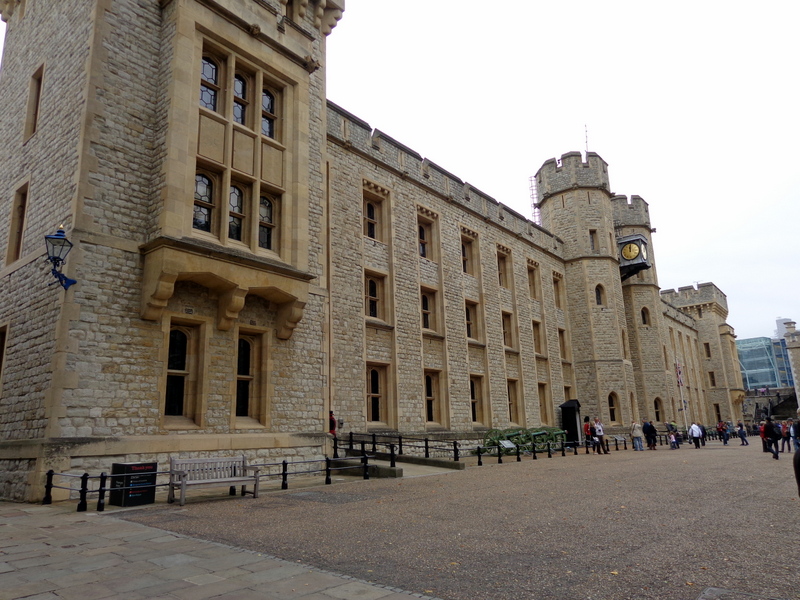
On our own, we went through the Waterloo Barracks where the Royal
Jewels are displayed. These jewels are not hidden away in a secret vault
but are on full display.
The center of the entire area focuses on the White Tower , which is
not only am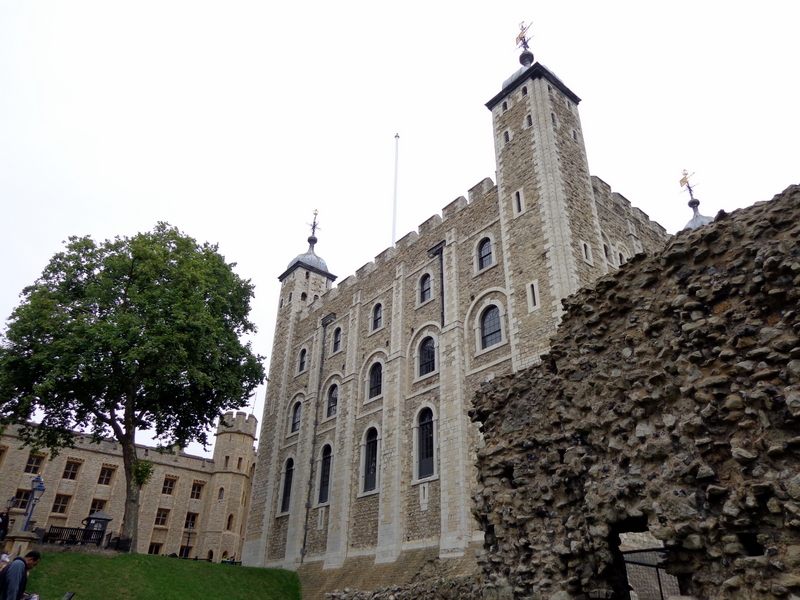 ong the best preserved and the most interesting 11th century
building in Europe, but since its creation by William the Conqueror has
been a potent symbol of authority and nationhood.
ong the best preserved and the most interesting 11th century
building in Europe, but since its creation by William the Conqueror has
been a potent symbol of authority and nationhood.
The White Tower has three main functions. First, it was itself
a fortress, and probably considered impregnable at the time of its
constructions. Secondly, it’s vast interiors must have been designed for
the King’s occasional use and as the setting for major governmental and
ceremonial functions. A third purpose was to serve as a permanent
reminder to the new No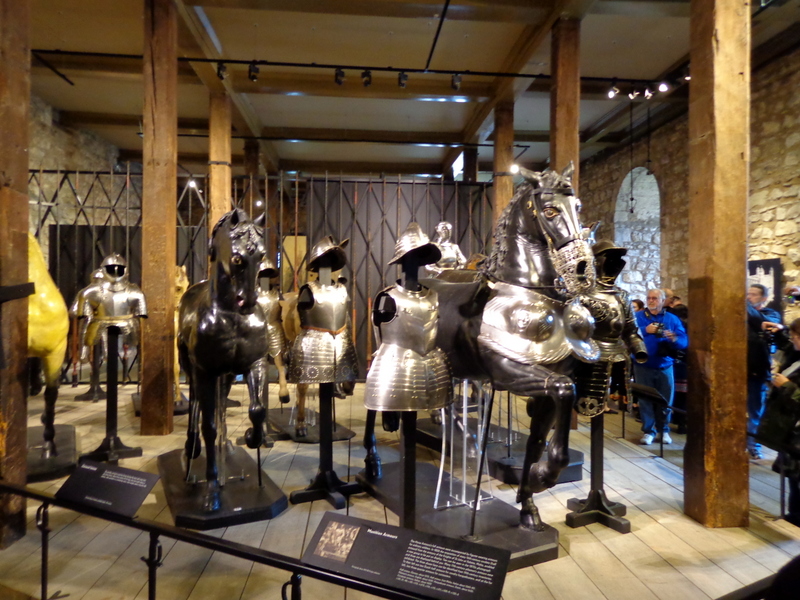 rman nobility and the native population of the
King's authority. From the 14th until the 19th century, the main use of
the White Tower was as a military storehouse. From this use it emerged
to the role it serves today as a museum of arms and armor. I walked up to
the second floor where armor is on display. It was an amazing sight.
rman nobility and the native population of the
King's authority. From the 14th until the 19th century, the main use of
the White Tower was as a military storehouse. From this use it emerged
to the role it serves today as a museum of arms and armor. I walked up to
the second floor where armor is on display. It was an amazing sight.
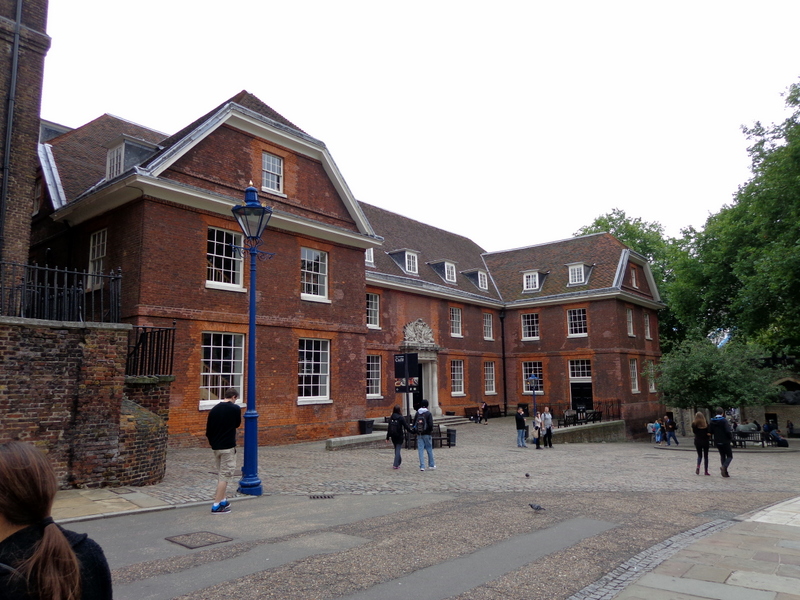 One of the buildings is now a café. We went in and ate lunch
sandwiches and a piece of cake. There was a huge crowd there with the
same idea. After walking on the wall and exploring other buildings, we
walked out to the wharf and caught a tour boat.
One of the buildings is now a café. We went in and ate lunch
sandwiches and a piece of cake. There was a huge crowd there with the
same idea. After walking on the wall and exploring other buildings, we
walked out to the wharf and caught a tour boat.
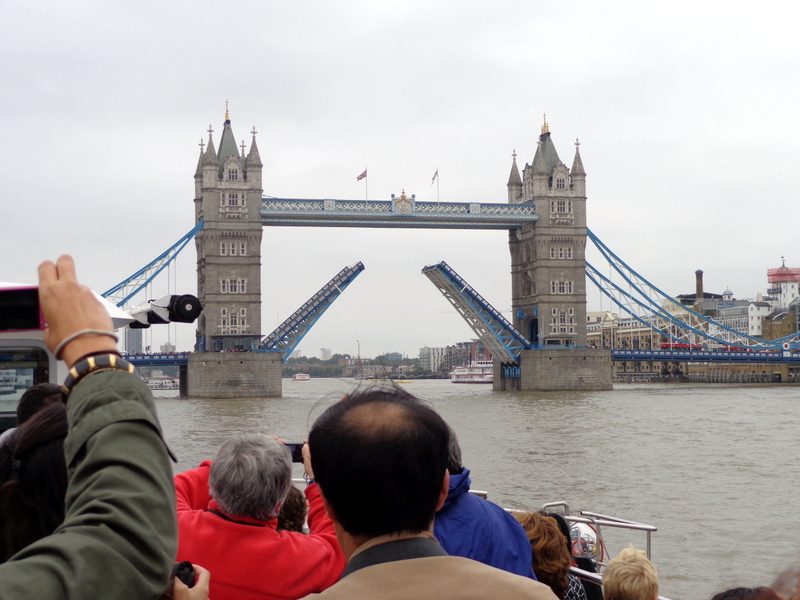
It was a huge boat and
it was filled. It wasn’t a very nice day, but we wanted to take a
boat ride and we were there. We were just in time to see the Tower Bridge
opened to allow a large sailboat to come through.
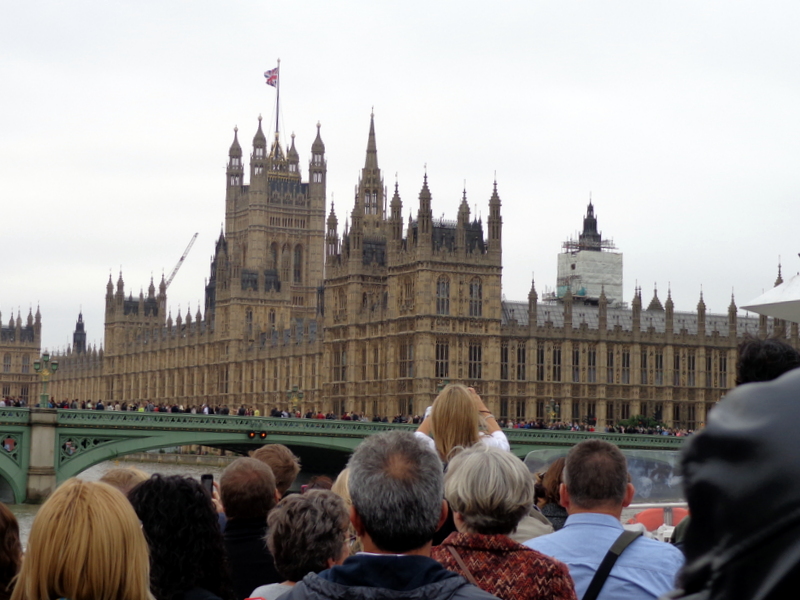 Our tour boat went down the Thames, and we got off at the
Westminster stop- Parliament, Big Ben, and and Westminster Abbey. We
didn’t stop in these buildings as we wanted to go to Trafalgar Square
and the National Gallery of Art.
Our tour boat went down the Thames, and we got off at the
Westminster stop- Parliament, Big Ben, and and Westminster Abbey. We
didn’t stop in these buildings as we wanted to go to Trafalgar Square
and the National Gallery of Art.
At the National Gallery of Art was a
painting of the Execution of Lady Jane Gray that Kathleen wanted to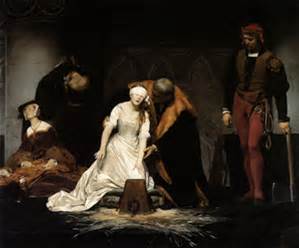 see,
as well as the Supper at Emmaus by Caravaggio. We looked at a few other
amazing and beautiful paintings. We had reservations in the museum’s
café for dinner because we were going to a concert at St. Martins-in-
the Fields at 7:30-which is located right across the street. When got
to the café they apologized but they had to close at 6:00 p.m. because
of tests of the building’s electrical system. They suggested several
other places, so we ate at Prezzo, which is a chain of Italian
restaurants. I had
see,
as well as the Supper at Emmaus by Caravaggio. We looked at a few other
amazing and beautiful paintings. We had reservations in the museum’s
café for dinner because we were going to a concert at St. Martins-in-
the Fields at 7:30-which is located right across the street. When got
to the café they apologized but they had to close at 6:00 p.m. because
of tests of the building’s electrical system. They suggested several
other places, so we ate at Prezzo, which is a chain of Italian
restaurants. I had
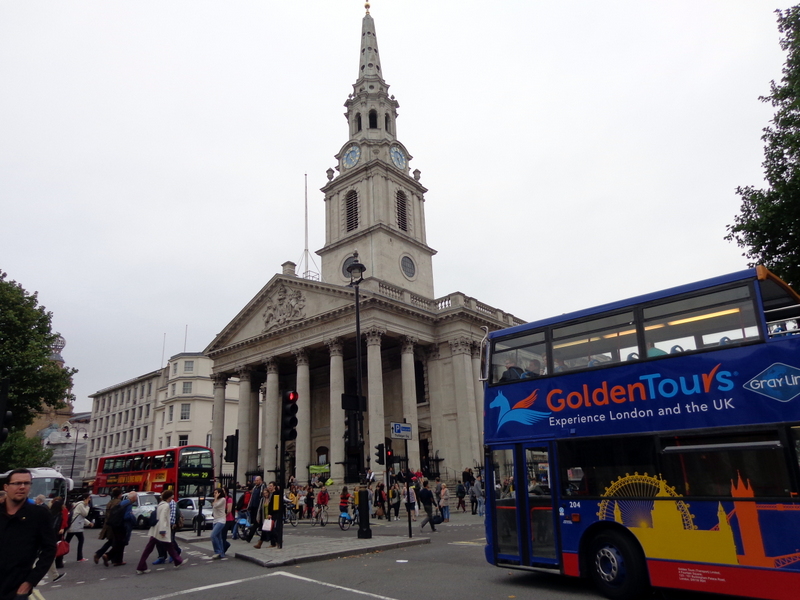 spaghetti and meatballs and Kathleen had chicken
carbonara. We shared a sticky toffee pudding.
spaghetti and meatballs and Kathleen had chicken
carbonara. We shared a sticky toffee pudding.
We walked across the street to
St. Martin’s. St. Martin’s , build
in 1721, is famous for its musical presentations which seem to happen
about every night. The churches most familiar feature is his grand
Corinthian portico, whose six columns are raised on a flight of steps
above the St. Martins Lane. The portico’s tympanum bears the arms of
King George I who is not only the reigning monarch when the church was
new, but was the churchwarden.
In the interior was very beautiful in a Georgian style. The east
end has a large Venetian window with a new
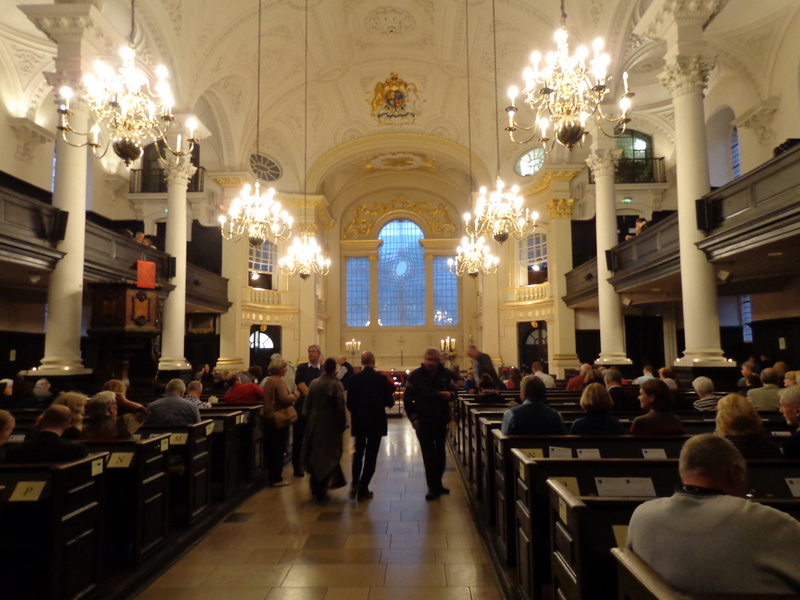 unusual glazing. The nave is
wide and spacious with tall columns. The ceiling is divided into gilded
hand-painted plasterwork panels. The Royal arms are prominently placed
over the chancel arch.
unusual glazing. The nave is
wide and spacious with tall columns. The ceiling is divided into gilded
hand-painted plasterwork panels. The Royal arms are prominently placed
over the chancel arch.
It is a large church and every seat was taken. We had made
reservations a long time ago, and we were sitting on row two, the first
and second seat from the center aisle. We were almost in the
orchestra. There was a 25-piece orchestra and will 45 -member choir.
The first half was three pieces by Hayden. After an intermission, they
presented Mozart’s Requiem. The music was wonderful and beautiful.
Kathleen figured out how to get home using the Tube. We had
to c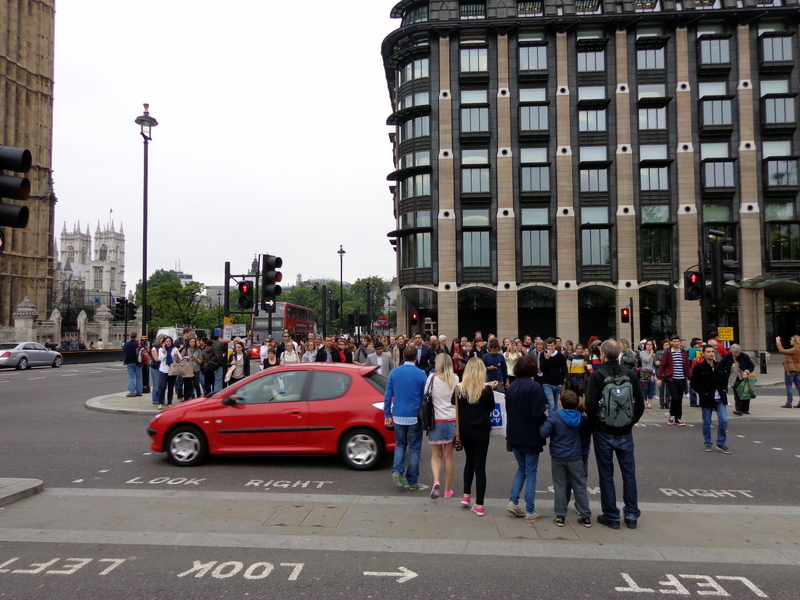 hange trains once, but we did fine. We had a big day and are really
tired. London is a very tiring town. It is so big and so crowded. It
is hard to walk around. When walking across some of the streets here
are hundreds of people on both sides and when the light changes both
side rush towards the middle. It is like a football game. This photo was
taken near the parliament earlier in the afternoon. All of the people
across the street are waiting for the light to change. An equal
number of people on my side of the street will meet in the middle. The Tubes are very
crowded and everyone is in a hurry.
hange trains once, but we did fine. We had a big day and are really
tired. London is a very tiring town. It is so big and so crowded. It
is hard to walk around. When walking across some of the streets here
are hundreds of people on both sides and when the light changes both
side rush towards the middle. It is like a football game. This photo was
taken near the parliament earlier in the afternoon. All of the people
across the street are waiting for the light to change. An equal
number of people on my side of the street will meet in the middle. The Tubes are very
crowded and everyone is in a hurry.
Tomorrow Mike and Val are going to pick us up at 10:00 and drive us
south. It is hard to believe that Monday is our last day.

 ed our steps from last night back to the Tower of London.
We bought our tickets and joined a tour.
ed our steps from last night back to the Tower of London.
We bought our tickets and joined a tour.  eds to
have at least 22 years of military service; to have reached the rank of
warrant officer; to have been awarded the long service and good conduct
medal and to be between 40 and 55 years old on appointment. They have
wonderful red uniforms and black hats. They get a lot of audience
participation and tell very funny stories.
eds to
have at least 22 years of military service; to have reached the rank of
warrant officer; to have been awarded the long service and good conduct
medal and to be between 40 and 55 years old on appointment. They have
wonderful red uniforms and black hats. They get a lot of audience
participation and tell very funny stories.  I was looking forward to seeing the Tower as I had made the model.
Everything looked just like the model or maybe it is the other way
around. The model on the left is an “aerial view” . This model is known as a
micro model and is the smallest model that I have made. The entire model
is only 14” x 10”. The White Tower in the middle is only 2” x 2”.
Click
here to see another view of the model.
I was looking forward to seeing the Tower as I had made the model.
Everything looked just like the model or maybe it is the other way
around. The model on the left is an “aerial view” . This model is known as a
micro model and is the smallest model that I have made. The entire model
is only 14” x 10”. The White Tower in the middle is only 2” x 2”.
Click
here to see another view of the model.  over the world in its power
and fascination. It is a World Heritage Site that welcomes over 2
million visitors a year. Countless books have been written about this
magnificent structure. Historic events of London, and indeed England,
occurred within its walls. In this brief account, I couldn’t possibly do
the history justice.
over the world in its power
and fascination. It is a World Heritage Site that welcomes over 2
million visitors a year. Countless books have been written about this
magnificent structure. Historic events of London, and indeed England,
occurred within its walls. In this brief account, I couldn’t possibly do
the history justice.  The guide took us in the Chapel Royal of St. Peter ad Vincula where
Ann Boleyn and Lady Jane Gray are buried as are many other famous
people, some of them were executed in the Tower. There are places in the
Tower where photos are not allowed, the chapel being one. The guide had
announced “no photos”. One young lady took a picture, the guide saw that
she was escorted out of the chapel.
The guide took us in the Chapel Royal of St. Peter ad Vincula where
Ann Boleyn and Lady Jane Gray are buried as are many other famous
people, some of them were executed in the Tower. There are places in the
Tower where photos are not allowed, the chapel being one. The guide had
announced “no photos”. One young lady took a picture, the guide saw that
she was escorted out of the chapel.  rent with a special scaffold
and block prepared each time, but all took place within a few yards
of each other. The memorial consists of a large glass circle with a
smaller raised circle above. The names of those executed are around the
edge of the circles. They include: Ann Boleyn, and the second wife of
Henry VIII; Catherine Howard, Henry’s fifth wife; Lady Jane Grey, Queen
for only nine days.
rent with a special scaffold
and block prepared each time, but all took place within a few yards
of each other. The memorial consists of a large glass circle with a
smaller raised circle above. The names of those executed are around the
edge of the circles. They include: Ann Boleyn, and the second wife of
Henry VIII; Catherine Howard, Henry’s fifth wife; Lady Jane Grey, Queen
for only nine days. Near this memorial was a raven who seemed to pose for several
photos. Legend says that the kingdom and the Tower will fall if the six
resident ravens ever leave the fortress.
Near this memorial was a raven who seemed to pose for several
photos. Legend says that the kingdom and the Tower will fall if the six
resident ravens ever leave the fortress. 
 see,
as well as the Supper at Emmaus by Caravaggio. We looked at a few other
amazing and beautiful paintings. We had reservations in the museum’s
café for dinner because we were going to a concert at St. Martins-in-
the Fields at 7:30-which is located right across the street. When got
to the café they apologized but they had to close at 6:00 p.m. because
of tests of the building’s electrical system. They suggested several
other places, so we ate at Prezzo, which is a chain of Italian
restaurants. I had
see,
as well as the Supper at Emmaus by Caravaggio. We looked at a few other
amazing and beautiful paintings. We had reservations in the museum’s
café for dinner because we were going to a concert at St. Martins-in-
the Fields at 7:30-which is located right across the street. When got
to the café they apologized but they had to close at 6:00 p.m. because
of tests of the building’s electrical system. They suggested several
other places, so we ate at Prezzo, which is a chain of Italian
restaurants. I had
